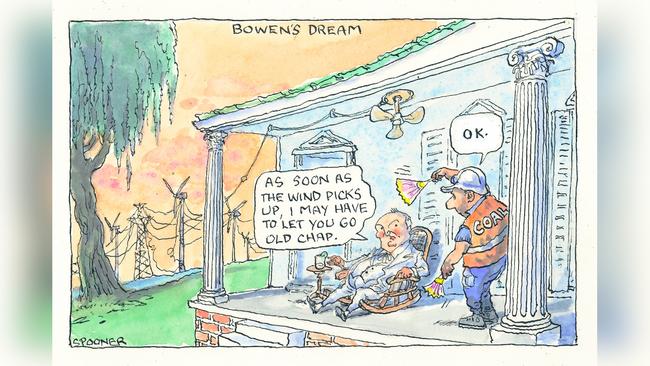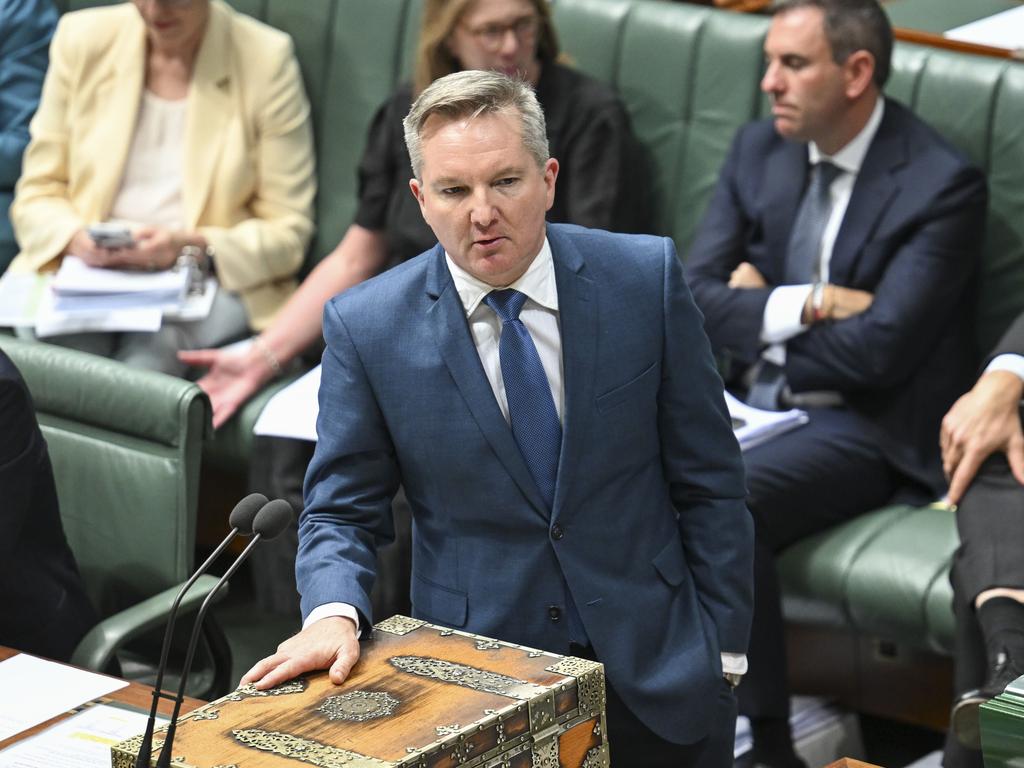Chris Bowen’s energy plan threatens to leave us in the dark
Australians were given a glimpse of the future this week when the call went out for NSW consumers to cut their electricity use to stop the grid from collapsing.

The old electricity system was built on the firm foundation of on-demand, fuel-burning generators that were made to serve us. Now we are slaves to the whims of the wind and the rotation of the Earth, as society’s life support system is rebuilt on the quicksand of occasionally available energy harvesters.
The evidence was explicit in words of NSW Premier Chris Minns – who has a disarming habit of appearing competent and honest – when advising his people of the need for energy rationing.
“Solar production in the energy markets starts to come off at 3pm, at exactly the same time as people return home from work,” Minns said. “If you can not run your pool filter, not run your dishwasher, not run your washing machine, this afternoon between 3pm and 8pm, you’ll help the grid.”
In the words of Michael Caravaggio, a director of research and development at the world-leading Electric Power Research Institute: “The fact that the sun sets every night isn’t a problem if I have 5 per cent of my energy from solar. It’s a significant issue if I want to get 100 per cent of my energy from solar.”
His point is self-evident: the more heavily any system relies on weather-dependent generation, the more its significant technical limitations are magnified.
So with some dispatchable generators offline for scheduled pre-summer maintenance and breakdowns in some ageing kit, the crunch came in NSW with the setting of the sun as solar harvesters clocked off.
Recall here that the central design feature of the future electricity system is that the fuel for 82 per cent of power generation will be sunshine, wind and hydro power. Right now its share is about 38 per cent. Today the profound limitations of weather-dependent generation are disguised by coal.
As coal exits, the growing burden of turning wind and solar into a reliable electricity system will fall on a complex mix of batteries, hydro power and gas.
That’s a pretty shaky mix. Batteries and hydro are not energy sources, they are energy storers. If wind and solar don’t generate excess power, there will be no battery storage to call on. And grid-scale batteries are very expensive and their capacity is not deep enough to run cities for long.

Hydro power also depends on the weather. In a water-poor country such as Australia, relying on hydro storage is rolling the dice. If, surprise, the east coast suffers a drought there won’t be enough water storage to cover the routine supply gaps left by wind and solar.
That happened, this year, in water-rich New Zealand. RNZ reported in August that the nation had hit an energy crisis after “months of dry weather have led to low hydro storage, and that along with falling gas reserves are being blamed for soaring wholesale electricity prices”.
As weather-dependent generation rises to become a dominant form of power production, the only source of reliable, dispatchable power will be gas. If we have gas.
This is the actual plan.
The man behind the plan is Climate Change and Energy Minister Chris Bowen.
Typically, his diagnosis of the low reserve event in NSW was a piece of performance art.
In an interview with Sky News’ tenacious Laura Jayes he delivered this observation: “The least reliable part of our energy grid at the moment is coal-fired power. That’s just a statement of fact. There hasn’t been a day in the last 18 months when we haven’t had a breakdown in a coal-fired power station.”
On Wednesday evening at 7pm in NSW 60 per cent of generation was coming from coal. Solar was contributing zero power and wind 9 per cent. While Bowen was on air with Jayes, black coal was supplying 60 per cent of the electricity in NSW and wind just 1 per cent.
In fact, across the past year, the Australian Energy Market Operator’s data dashboard records that brown and black coal supplied 64 per cent of the eastern grid’s electricity and gas 6 per cent. So 70 per cent fossil fuel then. Wind delivered 15 per cent of generation across the same time and grid-scale solar 8 per cent.
So coal is far and away the most reliable generator on the eastern national electricity market.
Search the arid desert of Bowen’s words and there are usually some grains of truth. It is true that, like Animal Farm’s loyal carthorse, Boxer, the dependable generators on the grid are being flogged to death to make up for the routine failure of wind and solar to show up for work.
But searching Bowen’s words for the truth is a Sisyphean task. Let’s return to the Sky News interview with Jayes, where she seemed somewhat unconvinced by the minister’s answers.
“Essentially we’re being gaslit to think that our energy system is reliable and cheaper,” Jayes said. “I can’t see any evidence of that.”
Bowen pounced: “Well, yesterday you saw the biggest reduction in energy prices in Australian history in the ABS statistics.”
Alas, Jayes did not have the bureau’s figures to hand but, moments later, Bowen let a small point slip. “That’s the impact of government policies, rebates, state and federal,” he said.
Jayes smelled a rat in the word garbage. “But hang on,” she said. “We’ve got to remove rebates from that because that’s not what you promised when you were promising the $275. Taxpayers are still paying for that.”
The promise Jayes was referring to is Labor’s December 2021 pledge that more wind and solar generation would add up to a $275 reduction in power prices by 2025.
With the benefit of time this column went to the Australian Bureau of Statistics’ latest consumer price index figures. It does record “electricity prices fell 17.3 per cent in the September quarter and 15.8 per cent in the past 12 months”.
It then notes this was entirely due to massive federal and state government rebates doled out to protect consumers from the huge electricity price increases they can see written in their bills.
The ABS also notes: “Excluding the rebates, electricity prices would have risen by 0.7 per cent in the September 2024 quarter.”
To use an old saying, there are lies, damn lies and statistics. And then there is Chris Bowen.
In Bowen world, pouring taxpayers’ money into electricity consumers’ pockets to shield them from enormous price hikes is proof that his plan to build a wind and solar-dependent grid is cutting the price of power.
Hard to argue with that. Mostly because it is nonsensical.
There is one thing the minister said that did make sense: “Australians will judge us on what we have done.” It’s up there with: “If you don’t like our policies, don’t vote for us.”





Australians were given a glimpse of the future this week when the call went out for NSW consumers to cut their electricity use to stop the grid from collapsing.